
-
quanly
Hagimex to Showcase Premium Vietnamese Products at Anuga 2025
Discover premium Vietnamese canned fruits and spices with Hagimex at Anuga 2025 – where quality meets global partners.
See moreStar anise is a popular spice used in many cuisines and herbal remedies. Known for its star shape and sweet, licorice-like flavor, it is used in both whole and ground form. Whether in pho soup, five-spice powder, or herbal teas, demand for star anise remains high.
In 2025, many buyers, producers, and exporters are paying close attention to the star anise price per kilogram. Understanding market trends helps businesses and consumers make smart decisions. In this article, we explore the current price of star anise, reasons for its fluctuation, and what to expect in the future.
As of early 2025, the star anise price per kilogram ranges between $6 to $12 USD, depending on the country of origin, quality, and processing method.
Lower-end prices (around $6–8/kg) usually apply to bulk purchases of dried star anise with basic sorting and packaging.
Mid-range prices (around $9–10/kg) are for clean, well-dried products suitable for food manufacturing and export.
High-end prices (around $11–12/kg or more) are for premium-grade star anise, often organic, hand-picked, or processed under strict food safety standards.
These prices can vary weekly depending on harvest conditions, export demands, and shipping costs.
-(1).jpg)
Most of the world's star anise comes from Vietnam and China. Vietnam is known for producing high-quality star anise with a strong aroma and oil content. Other countries like India, Laos, and Indonesia also produce smaller amounts.
In recent years, Vietnam has increased its export capacity, especially to Europe, the Middle East, and the United States. This has made Vietnamese star anise more visible on the global market, and it plays a major role in setting the international star anise price.
-(1).jpg)
Several important factors can change the market price of star anise:
1. Climate and Harvest Conditions
Star anise trees are sensitive to weather. Too much rain or long dry seasons can reduce harvest size. In 2024, some growing areas in China and Vietnam experienced irregular weather, which slightly decreased production. As a result, prices have increased in early 2025.
2. Global Demand
The demand for star anise remains strong due to its use in cooking, herbal products, and natural medicine. During cold seasons or health-related trends (such as flu-prevention teas), demand often rises, pushing prices higher.
3. Labor and Production Costs
Wages, fertilizer prices, and packaging costs all affect the final price. If local costs increase in producer countries, the export price will likely rise too.
4. Export Rules and Trade Agreements
Government policies on exports and international trade can also impact prices. For example, stricter quality checks or taxes may raise the final price of exported spices.
>>> See more: How to make star anise powder for cooking & herbal use
Compared to 2023 and 2024, prices in 2025 have stayed relatively stable but slightly higher overall. In 2023, prices ranged between $5.50 and $9.00 per kg. In 2024, due to reduced harvests in some areas, the price increased by 10–15%.
In 2025, we see a more balanced supply, but global inflation and logistics costs keep prices from falling back to 2023 levels.
Star anise is used by many different types of businesses. Its strong flavor and health benefits make it popular in both cooking and wellness products.
One of the biggest groups of buyers is spice importers and wholesalers. These companies buy large amounts of star anise and sell them to markets, food factories, and retailers. They care a lot about stable prices and good quality.
Another group includes tea producers. Star anise is often added to herbal teas because of its warm flavor and relaxing effect. Tea companies prefer star anise powder because it blends well with other herbs.
Food manufacturing companies also buy star anise to make sauces, spice mixes, or instant soups. These businesses need clean, safe spices that keep their flavor during cooking and packaging.
Retail brands and supermarkets sell star anise directly to customers. They usually focus on clean appearance, strong aroma, and clear product labels.
Lastly, some natural health and wellness companies use star anise in products like herbal medicine, oils, or supplements. These buyers often look for organic or chemical-free spices with clear origin information.
As star anise becomes more popular, buyers from all sectors are looking for reliable suppliers who offer good quality, food safety, and fair prices.
.jpg)
>>> See more: Hagimex - The number one supplier and exporter of star anise in Vietnam
Several market trends are shaping the future of star anise price and trade:
Organic and sustainable farming is growing. More buyers want spices that are eco-friendly and chemical-free, which can slightly increase price but also offer better quality.
Direct-from-farm sourcing is becoming more common. Buyers want to work directly with producers to ensure transparency and better margins.
Value-added processing is rising. Instead of just selling dried pods, companies now offer ground star anise, tea blends, and spice mixes — adding more value per kg.
.jpg)
The star anise price in 2025 remains steady but slightly higher than previous years due to climate factors, growing demand, and production costs. For food businesses, importers, and even home cooks, understanding these market trends helps with smart buying decisions.
If you want to purchase star anise that’s both affordable and high-quality, choosing a reliable supplier is key. Hagimex, a leading Vietnamese spice exporter, offers carefully selected star anise that meets global food safety standards. With consistent pricing, clear origin, and trustworthy service, Hagimex helps bring the true flavor of Vietnamese spices to your kitchen or business — fresh, natural, and responsibly sourced.

Discover premium Vietnamese canned fruits and spices with Hagimex at Anuga 2025 – where quality meets global partners.
See more